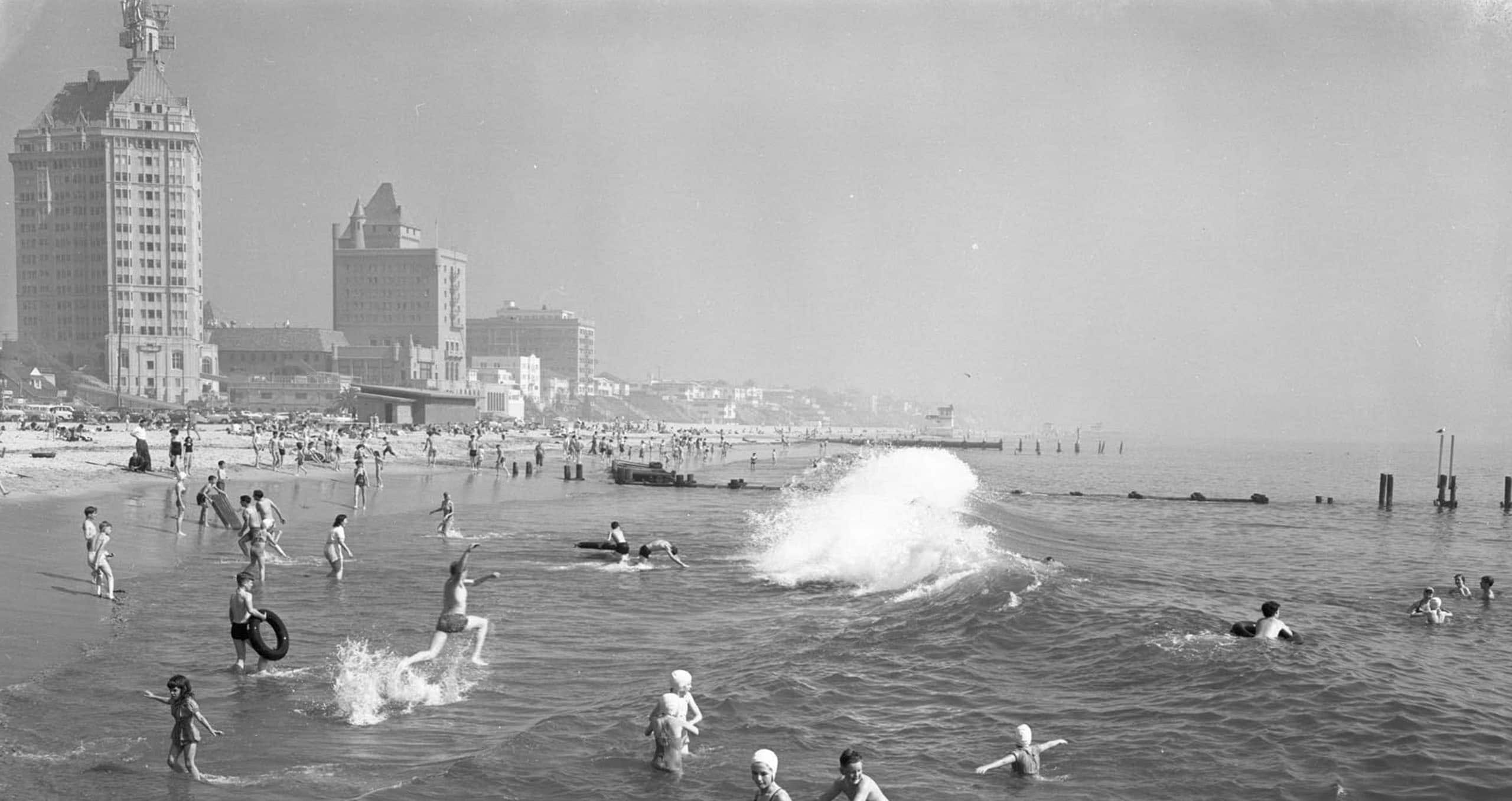In 1961, the Long Beach Kiwanis Club saw the need for an active society to preserve and present the History of our city. That dream was realized in 1962, more than seventy years after the city was founded, when civic leaders active in the Kiwanis and other organizations came together to form the Historical Society of Long Beach. The purpose of the newly organized Historical Society was to collect information about the city’s history, preserve that information and present it to the larger public.
As the Historical Society collected photographs, documents and other information, it became evident that it needed a home. The City of Long Beach provided a space in a small room at Rancho Los Cerritos. The office accommodated both the small collection of historical materials that people donated and the Historical Society’s business operations. Volunteers collected dues, published a newsletter, made the contents of the collections available to researchers and tried to help them find answers to questions about the city’s past.
In 1968 the Historical Society began publishing paperback books that highlighted photographs from its growing collection. The sale of these books along with the sale of reproduced photographs and dues helped support the group’s growth. The collections soon outgrew the one room at Rancho Los Cerritos. The office and archive moved into the Foreman’s Cottage at Rancho Los Alamitos for a while, then the Society returned to a somewhat larger space at Rancho Los Cerritos.
In 1983 the Historical Society had the opportunity to move into a larger space in the Long Beach Senior Center. There a small but dedicated group of volunteers maintained its collections, made them available to researchers, and helped people with all sorts of historical questions. The volunteers published additional books focusing on two significant Long Beach subjects, the Pike and the 1933 Earthquake, they continued to sell reproduced photographs, and used the Senior Center’s auditorium for public meetings. This group was so successful in expanding membership, book sales, photograph sales, and the collection of historical materials that a larger, independent space was necessary.
In 1992 an independent space was made available by Long Beach Plaza on historic Pine Avenue. With the work of many Historical Society volunteers, a grant from the Redevelopment Agency, and additional financial support from community members, the Historical Society assembled a team to plan and carry out construction. As a result, the Pine Avenue storefront was transformed into a gallery, office, archive and research facility. There students, genealogists, preservationists, architects, developers, city staff from various departments and other researchers, accessed the Historical Society’s collection for research.
Today, the Historical Society’s collection includes about 100,000 photographic images, photographic prints, and negatives. They range from fragile glass plate negatives to volatile nitrate negatives made through the 1930s, to Polaroid snap shots and color prints. The Historical Society also has large groups of images made by local commercial photographers Lawrence Inman and the Winstead Brothers between the 1920s and 1960s. In addition, there are more than 1,300 picture postcard images, along with an extensive collection of city directories, maps and map books, real estate records, architectural drawings, blueprints, thousands of documents, papers, pamphlets, brochures, booklets and some three dimensional artifacts.
The Historical Society is funded by the generous support of its members and bequests to establish a separate Trust Fund. Most of the Fund’s principal is designated for use as a museum building fund. Some of its income, however, is used for operating support. By 1995, income from the trust, memberships, contributions, and the sale of books and photographs allowed the Historical Society to employ an Executive Director. Today the Historical Society has three professional staff members, an Executive Director, an Office & Gallery Manager, and a Membership Manager.
Following the leadership of the new Director, the Historical Society purchased archival quality boxes, sleeves and other preservation materials in which to store and protect the many fragile items in the collection. It also bought sturdy shelves on which the items could be organized so they would be easier to find and use. In addition, the Historical Society purchased computers and software, which enabled staff and volunteers to facilitate inventorying and cataloging of the collection. This in turn increased the collection’s accessibility to the public. These significant changes better preserve the collection’s unique materials. Other repositories, such as the Long Beach Public Library, the ranchos and California State University, Long Beach hold some historical resources, none has the range of coverage or the volume of items that the Historical Society has.
During this period, the Historical Society completed the Institute for Museum and Library Services’ Conservation Assessment Program and Museum Assessment Program. These programs helped identify preservation priorities for the collection and educate the Board of Directors and staff on the best practices. Additionally, a Collections Manager was hired to organize and preserve the collection. The Board of Directors is committed to providing on going professional development for its staff. The staff regularly attends collections, museum, and public history workshops.
With this professional staff, the Historical Society also organizes special exhibits and presents many successful programs. One program explored the 1933 earthquake and asked those who remembered it to share their memories—the attendance was overwhelming. Another exhibit was Ocean Blvd: Community Landscapes presented with the help of a grant from the California Council for the Humanities. The Junior League of Long Beach helped to assemble and fund an exhibit of photographs from our collection, Women and Work in Long Beach. And each year the Historical Society sponsors Tell Me Your Story: Women’s Oral History and Essay Writing Celebration for school children that concludes with a public presentation of the best stories. The Josephine S. Gumbiner Foundation has funded this program for three years. Another important and popular Historical Society event is the Annual Historical Cemetery Tour of two local cemeteries. Visitors learn about the lives of some of the people who contributed to Long Beach’s development as they walk around and visit grave sites. These exhibits and programs, some of which have drawn more than 700 people annually, have helped the Historical Society maintain a strong visible presence in the community.
The Pine Avenue storefront was the Historical Society’s home from its opening in early 1994 until January 2000. Due to Long Beach Plaza’s closure, the Board of Directors began searching for a new home. The Relocation Committee found a space in the historic Breakers Hotel. Bernard Rosenson, the building’s owner, generously offered the Historical Society 4,300 square feet of space on the Arcade level. There the Historical Society had a spacious facility where many public programs and exhibits were held. For all of its benefits, the Breakers is a security building and was difficult for the public to access.
The Board of Directors began searching for a more publicly accessible site and thought that they had secured a permanent site. Because of this the owner of the Breakers made alternative plans for the space occupied by the Historical Society. In March of 2005, the Historical Society had to forfeit its gallery space and put a portion of its collection in storage. Fortunately the City of Long Beach provided office space for the organization in the historical Security Building at 110 Pine Avenue on the 12th floor. At this research center, people were welcomed to visit, purchase books and photographs, and conduct research.
In September 2006, the Historical Society and the City of Long Beach worked together to locate a suitable long-term location for the organization. The historic Harris Furs building at 4260 Atlantic Avenue in Bixby Knolls was identified as a ideal location for the organization. The 7,500 square foot building had been renovated to serve as an art gallery, making the space a perfect fit for the needs of the Historical Society. A generous donation by Camden Developers financed the purchase and required retrofitting of the building. In September 2007, the Historical Society moved in. The grand opening took place in December 2007, with an inaugural exhibit about North Long Beach, which was sponsored by the North Long Beach Community Action Group through a grant from the Navy Memorial Heritage Association.
The Historical Society’s collection supports a broad spectrum of users. For example, when the Chambers Group prepared the Historic American Engineering Report for the Ford Plant before it was demolished, they incorporated photographs commissioned by Ford taken by Lawrence Inman. These images are only available in the Historical Society’s collection. No where else in Long Beach can one study historical items as diverse as a special edition of The Labor News, photographs of the Toyota Grand Prix, knock down dolls from the Pike, photographs of the Recreation Department’s May Day celebrations, oil maps of the harbor, a copy of The Zaferia Advertiser, and real estate records from the Long Beach Land and Water Company. No other facility has a collection as broad or comprehensive. The Historical Society collects items like these and makes them available for public use by research or in the form of exhibits, programs, and publications.
And when Holden White Communications was employed to make a documentary video about the history of the Long Beach Naval Complex, they used photographs and other materials from our collection. When Long Beach Development and Associates began to redevelop the Walker Building they used copies of photographs from our collection to decorate the scaffolding while the work is in progress; they also used some of our images in their promotional materials. When the residents of the Villa Riviera were planning their seismic retrofit program, they looked at our photographs and promotional brochures for their building to guide their activities. When Steven Naing, manager of CollisionWorks.com in the historic Hancock Motors building was restoring his building, his work was guided by some of the Historical Society’s archival photographs. When Civil Engineer George Johnson needed to know when the railroad tracks were removed from Ocean Boulevard because he was designing structures for the City’s Queensway Bay development, he called the Historical Society’s staff for reliable information. When the Cultural Heritage Commission began to consider establishing a Historic District in California Heights, several members looked at City Directories, archival photographs, maps, and other materials to support their decision to pursue this nomination.
These are just a few examples of the public benefits which our collection and knowledgeable staff have provided. Our new facility has afforded us a greater opportunity to serve the public, closing our off-site storage facility and bringing all of our collections into one location. The move has made our entire archive available to researchers and better enabled care and preservation of the collection. For example, we are very concerned about our nitrate negatives. They are both deteriorating and volatile. Most experts believe that the safest and most effective place to store such negatives is in a freezer with temperature control. In our new facility, we have space to accommodate the freezer that McDonnell Douglas Employees Community Fund granted us money to purchase. We also have bought a special freezer storage system designed for long-term preservation. It allows us to control the humidity within each box where the negatives are kept inside the freezer. Thus negatives containing information, unavailable elsewhere, about local history can be protected and preserved.
In addition to hosting gallery exhibits in the new space, the large research center serves as a forum for local historical exploration. No where else in Long Beach can one study historical items as diverse as a special edition of The Labor News, photographs of the Toyota Grand Prix, knock down dolls from the Pike, photographs of the Recreation Department’s May Day celebrations, oil maps of the harbor, a copy of The Zaferia Advertiser, and real estate records from the Long Beach Land and Water Company. No other facility has a collection as broad or comprehensive. The Historical Society collects items like these and makes them available for public use by research or in the form of exhibits, programs, and publications.
— Julie Bartolotto and Kaye Briegel

